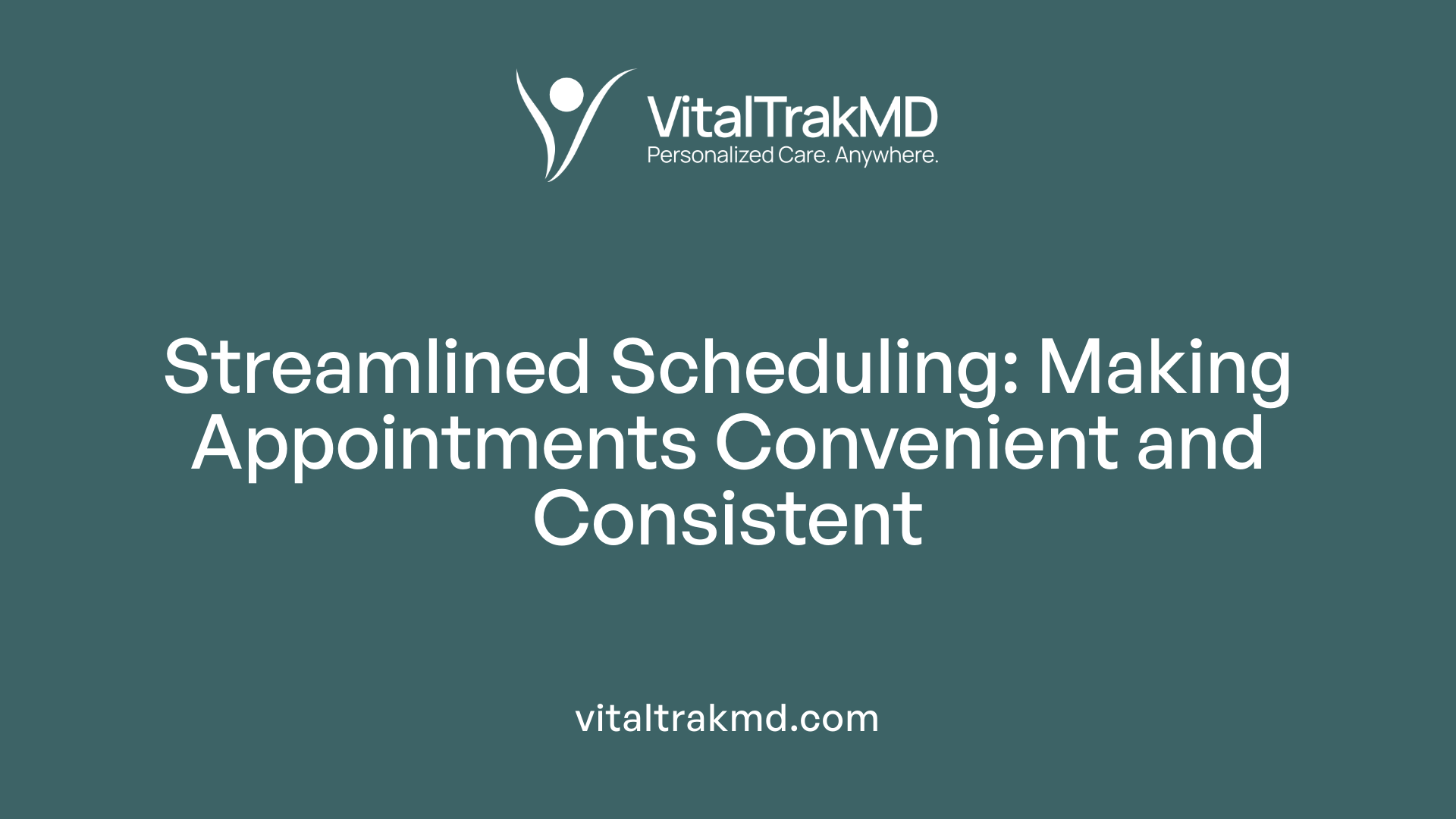Missed Appointments? How In-Home Care Can Improve Consistency

The Critical Role of Consistency in Reducing Missed Appointments
Missed healthcare appointments impose significant financial and health consequences, disrupting continuity of care and impairing patient outcomes. As an evolving solution, in-home care offers a promising approach to enhance appointment adherence through personalized, reliable, and accessible services. This article explores how in-home care frameworks can address common barriers, improve consistency, and ultimately prevent missed visits, ensuring sustainable healthcare delivery.
Supporting Outpatient Therapy and Recovery in the Home

How can in-home care services support outpatient therapy and recovery?
In-home care services play a crucial role in enhancing outpatient therapy and patient recovery by providing personalized, hands-on physical therapy directly in the comfort of a patient’s residence. This approach makes essential care accessible, especially for individuals facing mobility limitations, chronic conditions, or during times when visiting healthcare facilities is challenging, such as during a pandemic.
Therapists working in the home setting can tailor treatment plans to each patient's unique needs, focusing on restoring mobility, improving strength, enhancing balance, and managing pain effectively. They utilize portable or temporary equipment suited to the individual environment, ensuring therapy is both practical and effective.
A significant benefit of in-home care is the ability to conduct environmental assessments. Therapists identify potential hazards like loose rugs, poor lighting, or clutter that may contribute to falls or injuries. They provide education to patients and caregivers on how to modify the environment to promote safety, further supporting long-term independence.
The personalized nature of in-home therapy fosters better adherence to treatment plans, as patients are more comfortable and motivated in their familiar surroundings. This setting allows therapists to observe real-life challenges that may affect recovery and to adjust interventions accordingly.
Moreover, in-home care helps promote patient independence by empowering individuals with the knowledge and skills needed for ongoing self-care. This includes exercises, mobility techniques, and lifestyle adjustments aimed at maintaining health and preventing future setbacks.
Overall, in-home care services significantly support outpatient therapy and recovery by combining individualized treatment, environmental safety assessments, and education, all within a convenient and familiar environment. This holistic approach encourages long-term wellness, reduces hospital readmissions, and enhances quality of life for patients.
Reducing Missed Appointments with Engagement Strategies
How can patient engagement strategies reduce the likelihood of missed appointments?
Patient engagement plays a critical role in minimizing no-shows by making sure patients are actively involved in their care process. One of the most effective tools involves automated reminder systems that send SMS messages, emails, or phone calls. These reminders ensure patients receive timely alerts about upcoming appointments, tailored to their preferred communication method, increasing the likelihood of attendance.
Beyond basic reminders, providing personalized follow-up messages after missed appointments can help reinforce the importance of ongoing care. Follow-up outreach shows care, keeps the patient engaged, and encourages rescheduling. This proactive communication not only addresses forgetfulness but also demonstrates attentiveness, fostering trust.
Another vital aspect is offering flexible scheduling options. By extending clinic hours and allowing online or same-day booking, clinics accommodate patients' busy lifestyles. Additionally, transportation support like ride-sharing partnerships or shuttle services removes one of the most common barriers—lack of transportation—making it easier for patients to attend.
Building and maintaining a strong relationship between patients and providers enhances accountability and commitment. Clear communication, empathetic dialogue, and education about the significance of consistent healthcare reinforce patient motivation.
Research supports that the combination of technology-driven reminders, personalized communication, flexible schedules, and transportation solutions effectively reduces no-shows. This integrated approach improves operational efficiency, enhances patient health outcomes, and boosts overall satisfaction.
In summary, engaging patients through tailored reminders, active follow-up, adaptable scheduling, and logistic support creates an environment where patients are more likely to keep their appointments, leading to better health management and reduced financial impact on healthcare providers.
Harnessing Technology for Better Follow-up and Appointment Adherence

What technological tools can improve follow-up and reduce missed healthcare appointments?
Technology plays a vital role in addressing the persistent issue of missed healthcare appointments. Modern solutions include AI-driven virtual assistants, chatbots, automated reminder systems, and virtual visit platforms, all designed to simplify the appointment process and enhance patient engagement.
AI-powered virtual assistants and chatbots can handle routine follow-up tasks, such as scheduling, rescheduling, and answering patient queries around the clock. These tools facilitate timely communication through text messages, emails, or voice calls, making it easier for patients to remember and attend their appointments. Automated reminders—delivered via SMS, email, or app notifications—serve as gentle prompts that significantly reduce forgetfulness and last-minute cancellations.
Implementing self-scheduling features online or through mobile apps empowers patients to book or adjust appointments at their convenience, fitting healthcare visits seamlessly into busy schedules. Moreover, virtual visits eliminate barriers like transportation issues or mobility constraints, allowing patients to consult healthcare providers from home, which notably decreases no-show rates.
Advanced predictive models analyze historical appointment data to identify patients at higher risk of missing their visits. This information enables clinics to proactively send targeted reminders or outreach, optimizing resource allocation and appointment slot usage. AI-driven scheduling tools can also respond instantly to cancellations or no-shows, filling vacancies quickly and maintaining clinic efficiency.
Front desk operations benefit from AI-enabled virtual receptionists that manage check-ins, process patient information, and coordinate schedules. These mechanisms streamline workflows, minimize errors, and facilitate smooth patient experiences.
When integrated with electronic health records (EHR) and practice management systems, these technological tools provide real-time updates on appointment statuses, reduce administrative burdens, and improve overall operational efficiency.
In summary, leveraging digital innovations such as AI assistants, automated reminders, virtual visits, predictive analytics, and real-time scheduling enhances communication, convenience, and adherence, ultimately leading to fewer missed healthcare appointments and better patient outcomes.
Building Consistency in In-Home Care for Better Appointment Attendance
How can consistency in in-home care improve appointment adherence?
Establishing consistent care in the home setting plays a crucial role in improving patient commitment to scheduled appointments. When caregivers develop familiarity with clients over time, patients tend to feel more comfortable, trusting the caregiver and the care process more deeply.
This sense of trust encourages patients to adhere to their care schedules, recognizing that their health needs are understood and prioritized. Reliable and punctual caregiving reinforces routines, making it easier for patients to incorporate appointments into their daily life.
Continuity of care allows caregivers to closely monitor health changes, identify early signs of deterioration, and address issues promptly. Such attentive, ongoing interactions motivate patients to stay engaged with their treatment plans, including attending follow-up visits.
Furthermore, consistent scheduling and communication create a dependable environment, reducing anxiety and confusion for clients, especially those with complex health conditions or cognitive challenges.
Regular, predictable visits foster strong relationships, making patients feel valued and understood. Caregivers who are familiar with individual preferences and routines can tailor their support, which enhances satisfaction and encourages future attendance.
Staff continuity is also essential. When clients interact with the same caregivers, it minimizes unfamiliarity and discomfort. These stable relationships build emotional bonds and reinforce the importance of maintaining regular appointments.
Overall, consistency in in-home care supports a structured, trusting environment that promotes adherence, improves health outcomes, and enhances the overall quality of life for clients.
How does ongoing, reliable care foster adherence?
Ongoing, reliable care builds a foundation of trust between patients and providers. When caregivers are punctual, attentive, and consistent, patients perceive a sense of stability and predictability, which motivates them to follow through with scheduled visits.
Reliability in care delivery ensures that health assessments, support, and education are received regularly, reinforcing the importance of ongoing treatment. This consistency helps patients understand that their wellbeing is a continuous process, not a series of isolated visits.
Moreover, reliable care facilitates better communication. Patients are more likely to share relevant concerns, obstacles, or fears when they trust their caregivers, enabling proactive solutions to barriers such as transportation or understanding of health instructions.
This ongoing relationship also enables caregivers to notice subtle changes in health or behavior, prompting early interventions that reinforce the value of staying engaged with scheduled appointments.
In essence, dependable care establishes a rhythm and routine that patients internalize, making adherence a natural part of their health management.
What is the impact of consistent scheduling and communication?
Consistent scheduling and clear communication are foundational to fostering adherence to appointments. When patients receive reminders and updates through their preferred channels—whether calls, texts, or emails—they are less likely to forget appointments.
Predictable scheduling helps patients plan their day and allocate resources, such as transportation or caregiver assistance, effectively. When appointments are set at regular, expected times, patients develop habits of attending without last-minute concerns.
Effective communication extends beyond reminders. It involves providing detailed information about the visit, addressing questions proactively, and confirming upcoming appointments, which boosts confidence and commitment.
Open, transparent communication also helps manage patient expectations and fosters a collaborative relationship. Patients who feel well-informed are more likely to perceive appointments as important milestones in their health journey.
Enhanced communication reduces misunderstandings and helps address barriers early, thus decreasing the likelihood of no-shows. When combined with reliable scheduling, these strategies create a seamless, patient-centered approach that encourages ongoing participation.
| Aspect | Benefit | Additional Details |
|---|---|---|
| Building Trust | Increases patient comfort and commitment | Trust arises from familiarity and consistent, attentive caregiving |
| Enhancing Communication | Promotes better understanding and engagement | Regular updates and personalized contact reinforce importance of appointments |
| Scheduling Reliability | Establishes routines and predictability | Fixed times and reminders help embed appointment adherence in daily life |
| Care Continuity | Improves health outcomes | Ongoing relationships allow for timely interventions and tailored care |
| Emotional Connection | Strengthens patient-provider bonds | Consistent caregivers foster trust and loyalty |
Building consistency in in-home care isn't just about routine — it's about creating a dependable, trusting environment where patients feel valued, understood, and motivated to maintain their health through regular appointments.
Optimizing Scheduling Practices to Promote Adherence

How do scheduling practices influence appointment adherence?
Effective scheduling practices are vital for ensuring patients attend their medical appointments, which directly impacts health outcomes and practice efficiency. When scheduling systems are streamlined and patient-centric, they foster easier access and reduce barriers to care.
One of the most impactful strategies is the use of online booking platforms. These digital tools allow patients to select convenient times, reschedule easily, and receive immediate confirmation, which helps reduce forgetfulness and inconvenience. Automated reminders via text messages, emails, or push notifications serve as nudges, reinforcing appointment details and decreasing no-shows.
Flexibility in scheduling is also crucial. Providing options such as extended hours, same-day appointments, or online booking helps accommodate varied patient needs and life circumstances. For example, busy working patients may appreciate evening or weekend slots.
Incorporating advanced technologies like telehealth not only expands access but also offers an alternative when in-person visits are difficult. AI-driven scheduling systems can analyze patient data, predict high-demand periods, and optimize appointment slots dynamically, increasing clinic capacity and patient adherence.
Evidence from various case studies underscores that these practices significantly lower missed appointments. Clinics utilizing these innovative strategies report enhanced resource utilization, higher patient satisfaction, and improved health outcomes.
In summary, thoughtful scheduling approaches—leveraging technology and flexibility—are essential in promoting adherence, reducing no-shows, and ensuring smooth healthcare delivery.
Best practices to enhance appointment compliance
| Practice | Implementation Details | Impact |
|---|---|---|
| Online booking platforms | Patients select preferred times digitally, 24/7 access | Increased convenience leads to higher appointment attendance |
| Automated reminders | Text, email, or app notifications before appointments | Reduce forgetfulness and last-minute cancellations |
| Flexible scheduling | Evening, weekend, or walk-in appointments | Accommodates patient schedules, enhances access |
| Telehealth options | Video consultations as an alternative to in-office visits | Reduces transportation barriers and increases engagement |
| AI-powered scheduling systems | Analyze patient data, predict demand, optimize slots | Maximize clinic capacity, reduce wait times |
| Multichannel communication methods | Combine calls, texts, emails, and in-app alerts | Covers patient preferences, enhances communication effectiveness |
Personalizing appointment management based on patient needs
Tailoring scheduling approaches to individual needs improves adherence dramatically. For example, patients living far from the clinic or with mobility challenges benefit from telehealth options and extended hours. Patients requiring interpreter services may need appointment confirmations in their native language and reminders that include assistance with transportation.
Patients with chronic conditions often require more frequent or longer appointments. Recognizing these patterns allows clinics to proactively schedule follow-ups, reducing missed visits and enhancing care continuity.
Involving patients in scheduling decisions also fosters engagement. When patients select times that fit their routines and receive clear instructions with calendar invitations, they are more likely to keep appointments.
Factors affecting appointment adherence:
- Distance from healthcare facility
- Transportation availability
- Language and communication barriers
- Appointment complexity and duration
- Patient health literacy and understanding of importance
By considering these factors, healthcare providers can implement more effective and personalized scheduling strategies that align with patient circumstances.
Flexibility and responsiveness in appointment management
Flexibility in scheduling—such as online rescheduling, same-day slots, and walk-in options—offers patients control and convenience. Responsive practices, including quick follow-up on cancellations and real-time adjustments to appointment calendars, demonstrate attentiveness and support.
Providing multiple avenues for rescheduling and immediately confirming changes helps prevent gaps in care and reinforces patient commitment. For example, contacting patients promptly after missed appointments to discuss barriers and offering alternative times increases adherence.
Furthermore, creating clear policies about cancellations and no-shows, communicated transparently, can deter last-minute cancellations. When patients understand the consequences and opportunities for rescheduling, they are more motivated to attend.
Technological solutions like AI-driven algorithms can respond instantly to scheduling conflicts or no-shows, reallocating appointments to maximize clinic utilization.
In conclusion, flexible and responsive scheduling fosters patient trust, promotes ongoing engagement, and ultimately leads to higher adherence rates, vital for both health outcomes and efficient healthcare operations.
Strategies for Effective Management of Missed Appointments
What are best practices for managing missed healthcare appointments?
Managing missed healthcare appointments effectively requires a combination of proactive communication, policy enforcement, and addressing social barriers. Implementing automated reminders through multiple channels such as text messages, phone calls, and emails significantly reduces forgetfulness, one of the most common reasons for no-shows. Live confirmation calls further reinforce appointment attendance.
Developing and strictly enforcing no-show and cancellation policies helps set clear expectations for patients. These policies should outline possible consequences, such as rescheduling limits or fees, and should be communicated clearly during appointment scheduling. Accurate documentation of all outreach attempts, patient responses, and follow-up actions maintains accountability and informs ongoing engagement strategies.
For patients at higher risk of no-shows, practices should consider tailored interventions, including follow-up letters, certified mail, or even home visits when appropriate. Repeated missed appointments could necessitate discharge, following professional guidelines, to optimize resource utilization.
Flexibility plays a vital role; offering online booking, extended hours, and telehealth options makes it easier for patients to attend appointments. By reducing logistical barriers, clinics can improve overall adherence.
Addressing social determinants of health, such as transportation and financial issues, is essential. Partnerships with ride-sharing services or providing shuttle services help overcome transportation challenges. Additionally, offering financial counseling or sliding scale fees alleviates economic burdens that may prevent attendance.
Staff training focused on empathy, cultural competence, and effective communication enhances patient engagement. When patients feel understood and valued, their likelihood of attending appointments increases.
Implementing these best practices creates a comprehensive approach to reduce missed appointments, leading to better health outcomes, increased operational efficiency, and higher patient satisfaction.
The Financial Impact of Missed Appointments and How In-Home Care Can Help

Cost Implications of No-Shows at Healthcare Clinics
Missed appointments, commonly known as no-shows, have a significant financial impact on healthcare providers. When patients fail to attend scheduled visits, clinics often face wasted resources, including staff time, administrative costs, and unused appointment slots. These gaps not only lead to operational disruptions but also decrease overall productivity.
In addition to operational costs, missed visits contribute to inefficient use of medical resources. Providers cannot utilize the time slot effectively, which could have been allocated to other patients needing care. This underutilization results in a cascade of financial losses that can affect the sustainability of healthcare practices.
Estimating Revenue Loss Due to Missed Appointments
Numerous studies highlight that missed appointments cost the U.S. healthcare system approximately $150 billion annually. On a more individual clinic level, each missed appointment averages around $200 in lost revenue. For some clinics, especially those with high no-show rates—ranging from 14.9% (such as in VA healthcare systems) to over 30%—the annual monetary loss can reach hundreds of thousands of dollars.
For example, considering a mid-sized clinic that schedules 1,000 appointments monthly with a 20% no-show rate, the clinic could lose about $48,000 monthly—equating to over $576,000 annually. These figures underscore how missed appointments collectively drain healthcare financial resources, limiting the ability to serve more patients effectively.
| Number of Missed Appointments per Week | Estimated Monthly Revenue Loss | Estimated Annual Loss | Notes |
|---|---|---|---|
| 10 appointments | $2,800 | $33,600 | Based on average $200 loss per missed appointment |
| 20 appointments | $5,600 | $67,200 | Twice as many missed visits |
| 50 appointments | $14,000 | $168,000 | High no-show scenario |
How In-Home Care and Technological Solutions Can Reduce Financial Losses
In-home care services, along with advanced scheduling and reminder systems, can significantly mitigate these financial impacts. Providing consistent, reliable in-home visits reduces the need for scheduled clinic visits, especially for chronic disease management.
Effective in-home care strategies include establishing a stable team of caregivers, utilizing technology for appointment reminders, and employing AI-driven predictive tools to identify at-risk patients. These measures boost attendance rates and improve health outcomes, preventing costly emergency interventions linked to missed routine care.
Moreover, leveraging telehealth options can eliminate barriers like transportation and mobility issues—common reasons for no-shows—further reducing non-attendance. Automated systems that send personalized reminders via SMS, email, or app notifications ensure patients remember their appointments, decreasing forgetfulness.
Incorporating flexible scheduling, prepayment strategies, and immediate follow-up after missed visits also helps improve attendance. Such adaptations enable clinics to optimize resource use and set a precedent for sustainable financial health.
The Big Picture: Financial and Operational Benefits
Successfully reducing no-shows does more than just improve revenue; it enhances overall practice efficiency and patient satisfaction. Fewer missed visits mean better continuity of care, improved health outcomes, and more efficient use of limited healthcare resources.
Operational savings come from decreased administrative burden, reduced need for overbooking, and improved staff morale. Financially, clinics can reallocate resources toward patient care, staff training, and expanding services, creating a cycle of improvement that benefits both providers and patients.
In conclusion, addressing appointment adherence through comprehensive strategies and technological solutions is crucial. Not only does it bolster financial stability for healthcare practices but also promotes higher quality, accessible patient care—ultimately fostering a healthier society.
Enhancing Care Quality and Patient Trust through Reliability
The importance of staff stability and caregiver-client relationships
Consistent staffing plays a vital role in fostering strong relationships between caregivers and patients. When support workers are stable and familiar with each client's needs and routines, it creates a sense of trust and safety. This continuity helps patients feel more comfortable, which encourages them to attend appointments regularly and engage actively in their care.
In home care settings, staff stability is especially crucial. Patients, particularly those with complex health conditions or cognitive impairments, often depend on familiar caregivers for reassurance and effective communication. Frequent staff turnover can lead to confusion, resistance, and increased anxiety, all of which contribute to missed appointments and poorer health outcomes.
Strategies like matching clients with suitable carers, providing dedicated support teams, and offering flexible scheduling options support stability. These efforts improve not only attendance rates but also overall satisfaction and health results.
How reliability influences patient satisfaction and loyalty
Patients value dependable care and consistent communication. Reliable services make patients feel remembered, valued, and understood, fostering a strong emotional connection. When appointments are consistently kept and caregivers are punctual and attentive, it enhances the overall experience.
Reliable care also reduces frustration associated with missed appointments, delays, or poor communication. Patients who experience dependable service are more likely to trust their healthcare providers, resulting in greater loyalty and likelihood of adhering to treatment plans.
Moreover, reliable scheduling and follow-up demonstrate professionalism and respect for patients' time, which builds confidence in the healthcare system. This trust encourages patients to seek care proactively, leading to better health management and improved outcomes.
The role of proper training and documentation in building trust
Effective training ensures caregivers understand the importance of reliability, proper communication, and following policies. Well-trained staff are better equipped to manage schedules, communicate effectively, and handle unexpected situations, reducing the chance of errors and missed appointments.
Accurate and thorough documentation also plays a critical role in building trust. When care needs, patient preferences, and previous interactions are meticulously recorded, future care becomes more personalized and consistent. This documentation provides a clear record that supports continuity, accountability, and transparency.
Proper training combined with diligent record-keeping fosters a culture of reliability. Staff become confident in their roles, patients feel assured that their care is carefully managed, and the practice demonstrates a commitment to quality standards. This integrated approach ultimately leads to higher patient satisfaction, improved health outcomes, and increased loyalty to healthcare providers.
The Significance of Data and Continuous Improvement in Appointment Management

Using data analytics to identify no-show patterns
Healthcare providers increasingly rely on data analytics to monitor and understand appointment adherence. By analyzing historical appointment data, practices can detect common factors associated with missed visits, such as specific times of day, appointment lead-time, and patient demographics.
For example, studies in large hospital settings revealed that longer lead times tend to increase no-show rates, while appointments with highly-rated physicians or those scheduled closer to the appointment date tend to have better attendance. Moreover, different patient groups may exhibit distinct behaviors, with older adults and females generally less likely to miss appointments.
Tracking these patterns allows clinics to implement targeted interventions, such as adjusting scheduling times or providing additional support to at-risk groups. Advanced data analysis can also predict which patients are more likely to miss appointments, enabling proactive outreach and rescheduling.
Implementing KPIs and regular audits for ongoing improvement
Key Performance Indicators (KPIs) provide measurable metrics to evaluate appointment adherence and operational efficiency. Common KPIs include no-show rates, cancellation rates, average scheduling lead-time, and patient satisfaction scores.
Regular audits of these metrics help practices identify areas needing improvement. For instance, a rising no-show rate might prompt reviewing and refining reminder systems, policies, or staffing arrangements.
Establishing routine review cycles—monthly or quarterly—ensures continuous monitoring. Through these audits, clinics can assess the effectiveness of interventions like automated reminders or flexible scheduling. They should also evaluate the impact of policies such as no-show fees or prepayment systems.
Consistent data reviews foster a culture of ongoing quality improvement, enabling adjustments based on actual performance rather than assumptions.
The role of AI and workflow automation in optimizing schedules
Artificial Intelligence (AI) and automation tools are transforming appointment management. AI-driven systems analyze vast amounts of scheduling data to identify trends, predict no-shows, and suggest optimal appointment slots.
Workflow automation integrates these insights into practice operations, automating reminders via calls, texts, or emails before appointments. These reminders can be personalized, including appointment details, transportation options, and motivational messages.
Moreover, AI can respond instantly to schedule changes, automatically rescheduling appointments or filling cancellations with waitlisted patients—maximizing utilization and reducing empty slots.
Tools like cloud-based scheduling platforms and Virtual Assistants further streamline check-ins, follow-ups, and documentation, reducing administrative workload. These innovations not only decrease missed appointments but also enhance patient experience and practice efficiency.
By continuously analyzing data through dashboards and integrating AI solutions, healthcare providers can adapt their appointment systems proactively. This dynamic approach ensures better adherence, improved resource allocation, and ultimately higher quality patient care.
| Aspect | Description | Benefits |
|---|---|---|
| Data Analytics | Monitoring appointment patterns and patient behaviors | Enables targeted interventions and predictive scheduling |
| KPIs & Audits | Establishing performance metrics and routine reviews | Supports continuous quality improvement |
| AI & Automation | Implementing smart scheduling and reminder systems | Increases attendance, reduces manual workload |
In conclusion, harnessing data and automation technologies plays a pivotal role in refining appointment management. Continuous improvement driven by real-time insights ensures practices can adapt strategies, reduce no-shows, and enhance overall healthcare delivery.
Transforming Healthcare Delivery with Consistent, In-Home Care
Addressing missed appointments holistically requires integrating patient-centered strategies, technological innovations, and reliable, consistent in-home care services. By fostering trust, leveraging data, and improving scheduling practices, healthcare systems can significantly reduce no-shows, enhance care continuity, and improve health outcomes. In-home care not only supports the physical and emotional well-being of patients but also strengthens operational efficiency, ensuring that healthcare delivery is both effective and sustainable in serving diverse populations.
References
- 10 Ways to Reduce Patient No-Shows in 2025 - Dialog Health
- Decreasing Missed Appointments at a Community Health Center
- 6 Ways to Decrease Patient No-Shows & Improve Scheduling ...
- Why Minimizing Missed Patient Appointments Is Essential for Practices
- Importance of Consistency in Outpatient Therapy | A+ Care LA
- 9 Proven Ways to Reduce Patient Cancellations - HIP Creative
- Why Consistency in In-Home Care Matters: Building Trust
Recent articles
Want to Feel Better and Live Healthier?
Join hundreds of patients taking control of their health with personalized care that fits their life – not the other way around.
Rated 4.8/5 by 32+ customers







